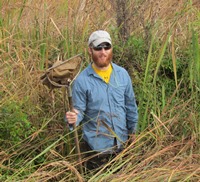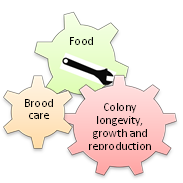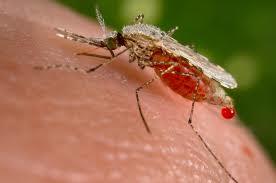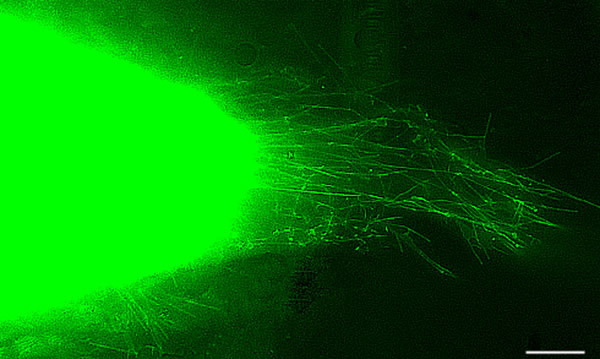 Ever wondered what creatures are lurking in your murky backcountry drainage ditches? Well, so has freshly-vindicated Dr. Alan Leslie. Through months of trudging through these mucky landscapes, he has sought to bring to light what is happening in the turbid depths of these ditches. Not only does the soil within contain a significant proportion of the Earth’s diversity, but these specialized environments are formed in juxtaposition of constantly fluctuating aquatic ecological systems and soil chemistry composition. The habitat acts as home to many critters that provide critical support for our agricultural food systems, energy cycling, and often serve as indicators for water quality. On the Eastern Shore of Maryland, 40% of the poorly drained land surface is used for agriculture, which places these ditches at an intersection of a significant proportion of water eventually trickling into our streams, rivers, and oceans…and drinking water. Think of these ditches not just as sporadic texture added to the otherwise flat agricultural landscape, but acting mitigation wetlands serving to reduce leaching of herbicides and pesticides; promote denitrification; and retain nutrients where they are most needed. The community mostly consists of organisms that are able to thrive in less than pristine conditions faced with constantly changing water volumes and chemical inputs. These impaired streams are brimming with different ecosystem engineering taxa that work to do similar jobs, even in the face of constant construction and deconstruction of the environment.
So who lives in the neighborhood? Alan discovered that 92.5% of everyone in the local ditch community lives at the water-sediment interface, right on beachfront property. Is it water quality that determines who settles down in a ditch?Surprisingly, no. Alan found that these burrowing invertebrate inhabitants did not correlate with water quality but did correlate with the size of the ditch. Effects of Pesticides on Honeybee Metabolic Physiology By: Steven Cook PhD  Dr. Steven Cook, Research Entomologist at USDA-ARS Bee lab, has shown that blends of pesticides can essentially ‘throw a wrench’ into a bee’s metabolic processes. He explained that constant detoxification might come at a high price. In order to keep the energetic budget balanced one or more basic biological functions (immunity, digestion, physical activity and basal metabolism) must compensate. Where exactly does the energy come from though? To calculate the cost of pesticides, Dr. Cook looked at the effects of commonly used pesticides and miticides on the metabolic physiology of caged nurse bees. Bees were exposed to different groups of compounds found in agricultural settings. One round of experiments focused on 2 controversial neonicotinoids, imidacloprid and clothianidin. Three variables were measured: 1) body weight, 2) metabolic rates (CO2/O2) via a technique calledrespirometry and 3) concentrations of two key nutritional components, lipids and proteins. As a worker bee’s role in the hive changes so, too, does its nutritional requirements. Thus measurements were taken at these normal transition phases (days 4, 7, 14 and 21). Dr. Cook found that physiological effects of the neonics were both compound and dose dependent. While many details can be gleaned from the graphs below, here are two interesting findings: by day 14 both compounds (at high doses) 1) drastically reduced protein content and 2) increased lipid content. GUY1 is developmentally regulated and is expressed in the embryonic stage of the mosquito life cycle. Once expressed, GUY1 is thought to bind to DNA, due to its specific helix-turn-helix shape, a structural domain commonly associated with DNA binding capabilities. The binding of GUY1 would then allow the expression of other genes, possibly involved in sex determination or dosage compensation. Expression of GUY1 in female mosquitoes results in total lethality by the early larvl stage; a phenotype which greatly skews the sex ratio of a population. By understanding the processes which causes this phenotype in mosquitoes, Dr. Criscione hopes to develop tactics to control the sex ratio in mosquito populations. This knowledge is critical to programs which use the release of sterile males (Sterile Insect Technique, SIT) or the release of insects carrying a dominant lethal gene (RIDL) to control mosquito populations. Sex-determination in the Anopheles mosquito is determined by the presence of specific sex chromosomes. Females possess two X chromosomes while males possess one X and one Y chromosome. By comparing sequence information between the male and female data sets, one can infer which regions are found exclusively on the Y, and therefore which sequences are associated with male specific genes. Using this conceptual approach, Dr. Frank Criscione was able to identify GUY1, a gene specific to the Y chromosome in mosquitoes, which is shown to generate a sex ratio bias when manipulated. Role of GUY1 in Mosquito Sex Determination
The Cytoneme Connection: Challenging our Knowledge of Paracrine SignalingAs we learned in colloquium earlier this semester, even the smallest arthropods have immense diversity in both body plan and development. According to Dr. Sougata Roy, a big contributing factor to this diversity is the ability of cells to communicate and induce changes in other cells. A major research interest of Dr. Roy’s is the function of cell structures called cytonemes in the development of Drosophila larvae. Cytonemes are well-known to be present during larval insect development and have been for quite some time, but until fairly recently, no one had researched their function. Belonging to a class of cellular protuberances called filipodia, cytonemes are filamentous structures known to be present in wing and eye imaginal disks in Drosophila and in the ovaries and embryos of several other invertebrates. Dr. Roy’s research suggests that these visually strange projections of the cell membrane play an integral role in paracrine signaling.
Paracrine signaling is generally known to involve releasing signal molecules directly into the extracellular fluid, which reach target cells slowly through diffusion. Dr. Roy believed that cytonemes may somehow facilitate this process, allowing the molecules to better home in on their target cells. Armed with countless Drosophila and red and green fluorescent biomarkers, he conducted several experiments to see if this could be the case. Margaret Palmer, SESYNC Executive Director and Professor at the University of Maryland, and Kelly Hondula, SESYNC Faculty Research Assistant, collected information on 434 mitigation projects throughout West Virginia, Kentucky, Tennessee, and Virginia. They found that criteria for projects to be deemed successful do not correspond with scientific standards for restoration. For full story, click on link.
http://www.sesync.org/news/mitigation-of-appalachian-coal-mining-not-meeting-cwa-reqs Dennis vanEngelsdorp in the New York Times: The Head-Scratching Case of the Vanishing Bees
Click on the link for video and full story. http://www.nytimes.com/2014/09/29/us/the-head-scratching-case-of-the-vanishing-bees.html?rref=us&module=Ribbon&version=context®ion=Header&action=click&contentCollection=U.S.&pg |
Categories
All
Archives
June 2024
|
Department of Entomology
University of Maryland
4112 Plant Sciences Building
College Park, MD 20742-4454
USA
Telephone: 301.405.3911
Fax: 301.314.9290
University of Maryland
4112 Plant Sciences Building
College Park, MD 20742-4454
USA
Telephone: 301.405.3911
Fax: 301.314.9290




 RSS Feed
RSS Feed




